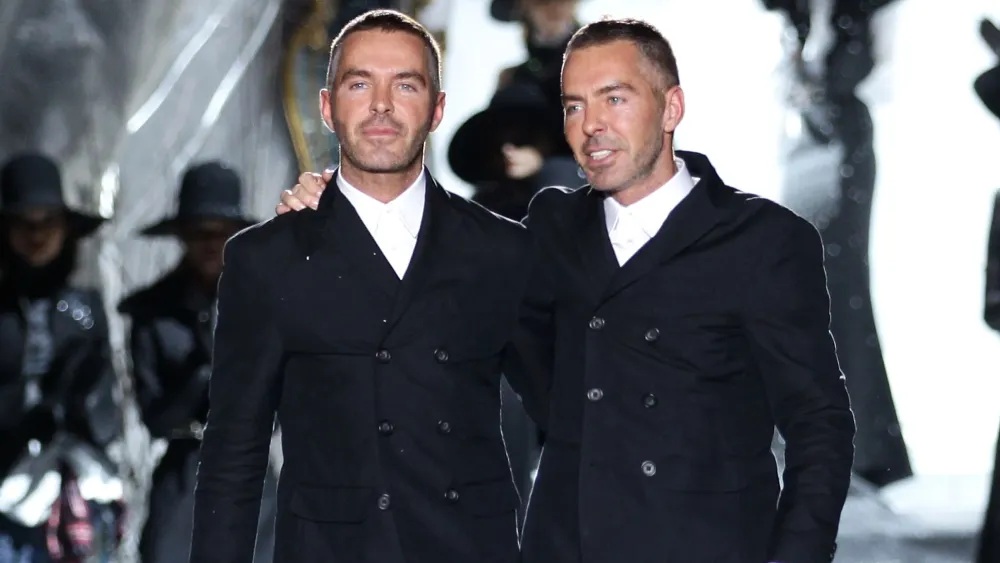This week’s Fashion Industry and Economic News exposes the turbulence behind the glossy runways — from Milan’s designer layoffs to factory fires in Bangladesh and strikes across France. Together, these events tell a broader story: the global fashion economy is facing an identity crisis.
Dsquared2 Layoffs: When Luxury Meets Harsh Reality
Milan, the beating heart of Italian fashion, is now witnessing a somber rhythm. Dsquared2, the globally recognized label known for its edgy aesthetics and unapologetic creativity, has announced the layoff of 40 employees, citing a “fashion downturn” and “profound and complex challenges.”
The decision paints a vivid picture of the industry’s current state. Despite fashion’s reputation for resilience and reinvention, even heritage and high-end labels are not immune to the economic chill sweeping across Europe. Rising material costs, slowed consumer spending, and unpredictable global events have created a perfect storm — one that even luxury houses are struggling to weather.
The “fashion downturn” isn’t just a business buzzword; it’s a reflection of shifting consumer priorities. Post-pandemic shoppers crave sustainability, versatility, and value — qualities that often conflict with the fast-paced, high-cost nature of luxury production. As Dsquared2 retrenches, the message is clear: creativity alone no longer guarantees profitability.
Bangladesh Garment Exports Disrupted: A Fire That Burned More Than Fabric
Across the globe, in Dhaka, Bangladesh, a devastating fire at the airport cargo complex has ignited economic shockwaves throughout the garment sector. Bangladesh, the world’s second-largest apparel exporter after China, depends heavily on timely exports to Western markets. The fire — which damaged storage facilities containing millions of dollars’ worth of goods — has now led to major delays and financial losses for countless factories and global retailers.
For a nation whose economy leans heavily on textile exports, this disruption could mean weeks of recovery and revenue decline. Industry experts estimate that hundreds of containers filled with ready-to-ship garments were destroyed or delayed, potentially causing missed deadlines for global fashion chains like H&M, Zara, and Primark.
This incident is more than a logistical nightmare — it exposes the fragility of the global supply chain that fuels the fashion industry. A single spark in Dhaka can ripple through New York’s fashion district or London’s luxury boutiques.
“Fashion today is a delicate tapestry of interdependence,” said an industry analyst. “When one thread burns, the entire pattern unravels.”
Kering Employees to Strike: The Human Side of Luxury Labor
Meanwhile, in Paris, Kering Group — home to luxury giants like Gucci, Saint Laurent, and Balenciaga — faces a different kind of disruption: its people. Employees across various European offices have announced strikes protesting the conglomerate’s decision to scale back remote work policies, a move seen as a regression from the flexible norms adopted during the pandemic.
Workers argue that the company’s sudden shift towards stricter in-office requirements ignores the work-life balance they had grown accustomed to. The strike reflects a deeper unrest in the fashion labor landscape, where employees are increasingly vocal about mental health, fair treatment, and sustainable workplace cultures.
This collective action, though not as visually dramatic as a runway protest, symbolizes a powerful statement: luxury can no longer be built on the quiet endurance of its workforce.
The Broader Picture: Fashion’s Economic Fracture Line
These three stories — layoffs in Milan, a fire in Bangladesh, and strikes in Paris — are not isolated incidents. They represent interconnected threads in the global fashion landscape. Together, they point to an industry under transformation, struggling to find equilibrium between profit and principle, tradition and technology, and creativity and commerce.
The global fashion market, once booming with double-digit growth, has entered a period of recalibration. Inflation has reduced disposable income, geopolitical tensions have increased shipping costs, and the sustainability movement has forced brands to rethink how and where they produce.
Fashion, once a symbol of endless reinvention, now faces an existential question: how do you sustain beauty when the system that supports it is cracking?
Luxury Labels and the “Downturn Dilemma”
Luxury fashion houses like Dsquared2 are often seen as untouchable — insulated from the turbulence of the mass market. Yet, the recent layoffs prove otherwise. Even the glittering world of Milan is not immune to cost pressures and consumer fatigue.
Analysts are calling it the “downturn dilemma” — a paradox where brands must choose between preserving exclusivity and embracing adaptability. For many, the solution lies in digital transformation, AI-driven production, and sustainable innovation.
However, transformation comes with a price. Restructuring costs, reduced margins, and fluctuating demand patterns have left many labels walking a financial tightrope. The runway has never felt narrower.
Supply Chain Fires and the Ripple Effect
The Bangladesh cargo fire has illuminated a long-standing vulnerability: overdependence on centralized supply chains. For decades, fashion brands have relied on low-cost garment production in South Asia. But as natural disasters, political unrest, and now industrial fires disrupt exports, companies are being forced to diversify sourcing.
Some European and American brands are exploring “nearshoring” — moving production closer to home in regions like Eastern Europe or North Africa. While this could reduce logistical risks, it also means higher costs and potential price hikes for consumers.
In essence, the smoke from the Bangladesh fire has clouded more than the skies; it’s obscured the illusion of fashion’s global stability.
The Workforce Revolution: Fashion Employees Demand Their Seat at the Table
Kering’s employee strikes underscore a broader shift in the industry’s workforce culture. Fashion has long thrived on passion, but passion alone no longer pays the bills — or sustains well-being.
Post-pandemic, employees have redefined what it means to “work in fashion.” Flexibility, respect, and mental health have become as crucial as creativity. The Kering protests may mark a turning point, pushing other luxury conglomerates — from LVMH to Prada Group — to re-evaluate their internal policies.
A spokesperson for the striking workers noted, “We create beauty for the world, but we also deserve a beautiful life.”
That sentiment captures the heart of the new labor narrative: fashion is no longer just about fabric; it’s about fairness.
Fashion’s Economic Pulse: Where Do We Go From Here?
The global fashion economy is estimated to be worth over $1.7 trillion, yet it feels increasingly fragile. The convergence of environmental crises, labor unrest, and shifting consumer ethics has placed immense pressure on brands to evolve.
Investors are now prioritizing ESG (Environmental, Social, and Governance) standards. Retailers are pivoting to slow fashion models, and consumers are turning toward second-hand and circular fashion.
Fashion’s future may no longer depend solely on seasonal collections but on economic resilience and social responsibility.
As one analyst aptly said, “Fashion’s next big trend isn’t aesthetic — it’s ethical.”
The Silver Lining: Reinvention Through Crisis
Despite the grim headlines, there is optimism in the air. The same industry that once reinvented silhouettes and standards can reinvent itself.
The Dsquared2 layoffs, while painful, may lead to smarter resource allocation and a renewed focus on digital couture. The Bangladesh fire may push for safer, more sustainable factory practices. The Kering strikes might ignite a new model of corporate empathy and inclusivity.
In fashion, crisis often precedes creativity. Just as designers turn flaws into features, the industry may yet turn its setbacks into strength.
FAQs About Fashion Industry and Economic News
1. What is causing the current downturn in the fashion industry?
The fashion downturn is driven by multiple factors — inflation, changing consumer habits, rising production costs, and the global economic slowdown. Consumers are spending less on luxury and more on sustainable, versatile pieces.
2. How will the Bangladesh fire affect global garment exports?
The fire is expected to cause major delays in shipping, lost inventory, and revenue declines for both local manufacturers and global retailers relying on Bangladeshi suppliers.
3. Why are Kering employees striking?
Employees are protesting the reduction in remote work options, demanding more flexibility and a better work-life balance — issues that have become central post-pandemic.
4. Are luxury brands like Dsquared2 at risk of collapse?
While not at risk of collapse, brands like Dsquared2 are restructuring to cut costs and adapt to reduced demand. The layoffs signal a strategic shift rather than an existential crisis.
5. What’s the future outlook for the fashion economy?
The future depends on innovation, sustainability, and diversification. Brands investing in technology, ethical practices, and local production will likely lead the next phase of global fashion recovery.
The Fashion Industry and Economic News this week reveals more than just headlines — it reveals humanity behind the hemlines, and the economy stitched into every seam. As fashion navigates this turbulent chapter, one truth remains: style may evolve, but resilience never goes out of fashion.
Read more on Sustainable Fashion Trends Reshaping Africa’s Design Industry
Learn more about global fashion trade updates from the World Trade Organization





